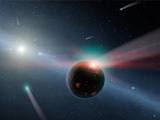|
|
TODAY.AZ / Weird / Interesting
How comets in distant solar systems could deliver oceans to exoplanets
22 October 2011 [11:40] - TODAY.AZ
 A pair of new comet studies from two space telescopes show how other planets might grow oceans. For the first time, astronomers have detected a ring of cold water vapor encircling a young star’s dusty planetary disk. And a separate study in a different star system shows a hailstorm of icy bodies could be bombarding a young planet. Together, the studies bolster a theory about how comets may have delivered Earth’s oceans — and they show this is not a unique occurrence in the universe.
A pair of new comet studies from two space telescopes show how other planets might grow oceans. For the first time, astronomers have detected a ring of cold water vapor encircling a young star’s dusty planetary disk. And a separate study in a different star system shows a hailstorm of icy bodies could be bombarding a young planet. Together, the studies bolster a theory about how comets may have delivered Earth’s oceans — and they show this is not a unique occurrence in the universe. Today's issue of the journal Science contains a paper describing cold water surrounding a young star called TW Hydrae, located in the Hydra constellation. Astronomers have previously found warm water around planet-forming regions, but not huge amounts of cold water. This cold reservoir demonstrates how comets form in a solar system’s outer reaches.
"Our observations of this cold vapor indicate enough water exists in the disk to fill thousands of Earth oceans," said astronomer and lead author Michiel Hogerheijde of Leiden Observatory in The Netherlands. TW Hydrae is just 10 million years old, and astronomers believe the dusty disk surrounding it will eventually coalesce to form planets. The frosty water vapor will probably coalesce to form comets, some of which might rain down on those new planets.
This does indeed happen in other solar systems, as a separate study shows. On Wednesday, astronomers using the cold-observing Spitzer space telescope described finding a dusty band around a star called Eta Corvi, a billion-year-old star system in the constellation Corvus, the crow.
The band’s contents strongly match that of an obliterated comet, suggesting a massive collision, perhaps with a planet. This sounded like what happened during Earth’s own Late Heavy Bombardment. The system has a second, bigger ring much farther out, just like our own Kuiper Belt. And the bombardment is even happening around the same time that ours did, about a billion years after the Earth formed.
During the Late Heavy Bombardment here, a cascade of frosty space rocks rained down on the planet, delivering water and other things. (Earth was too hot after its formation to hold on to any native H2O.) Earlier this month, researchers using the European Space Agency’s Herschel Space Observatory said they found the chemical isotope signature of Earth water out in the distant reaches of our solar system, suggesting that Oort Cloud comets may have been one source of this bombardment, not necessarily just asteroids. This new Spitzer study suggests the same type of bombardment is happening at Eta Corvi.
So it sounds like comet clouds and water reservoirs are not uncommon at all. Perhaps around each star’s a pool of water — which could mean very interesting things for the search for extraterrestrial life.
/Popular Science/
URL: http://www.today.az/news/interesting/96909.html
 Print version
Print version
Views: 1737
Connect with us. Get latest news and updates.
See Also
- 19 February 2025 [22:20]
Visa and Mastercard can return to Russia, but with restrictions - 05 February 2025 [19:41]
Japan plans to negotiate with Trump to increase LNG imports from United States - 23 January 2025 [23:20]
Dubai once again named cleanest city in the world - 06 December 2024 [22:20]
Are scented candles harmful to health? - 23 November 2024 [14:11]
Magnitude 4.5 earthquake hits Azerbaijan's Lachin - 20 November 2024 [23:30]
Launch vehicle with prototype of Starship made its sixth test flight - 27 October 2024 [09:00]
Fuel prices expected to rise in Sweden - 24 October 2024 [19:14]
Turkiye strikes terror targets in Iraq and Syria - 23 October 2024 [23:46]
Kazakhstan supplied almost entire volume of oil planned for 2024 to Germany in 9 months - 23 October 2024 [22:17]
Taiwan reported passage of Chinese Navy aircraft carrier near island
Most Popular
 Opening of regional communications: equating to TRIPP
Opening of regional communications: equating to TRIPP
 Shrines of Vardanyan family loot in Armenia devil in Baku
Shrines of Vardanyan family loot in Armenia devil in Baku
 President Ilham Aliyev meets residents relocated to Karkijahan settlement
President Ilham Aliyev meets residents relocated to Karkijahan settlement
 Türkiye seeks deeper investment ties with Azerbaijan at Baku Forum
Türkiye seeks deeper investment ties with Azerbaijan at Baku Forum
 Azercell backs expanded Children’s Paralympic Games in Azerbaijan
Azercell backs expanded Children’s Paralympic Games in Azerbaijan
 One in five teens worldwide faces an eating disorder
One in five teens worldwide faces an eating disorder
 President Ilham Aliyev attends inauguration of Faculty of Business and Economics building at Garabagh University
President Ilham Aliyev attends inauguration of Faculty of Business and Economics building at Garabagh University
